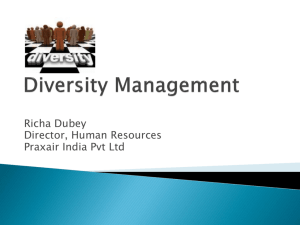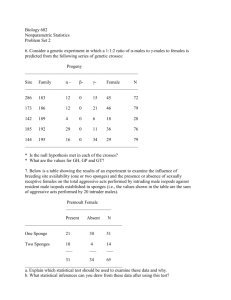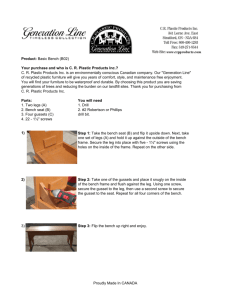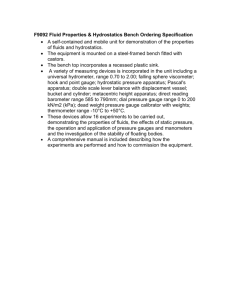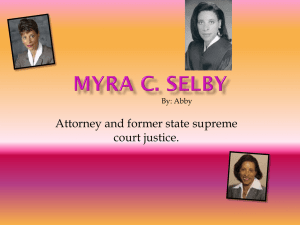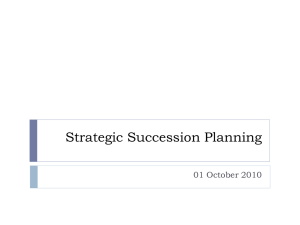Putting your Succession Plan into Action
advertisement
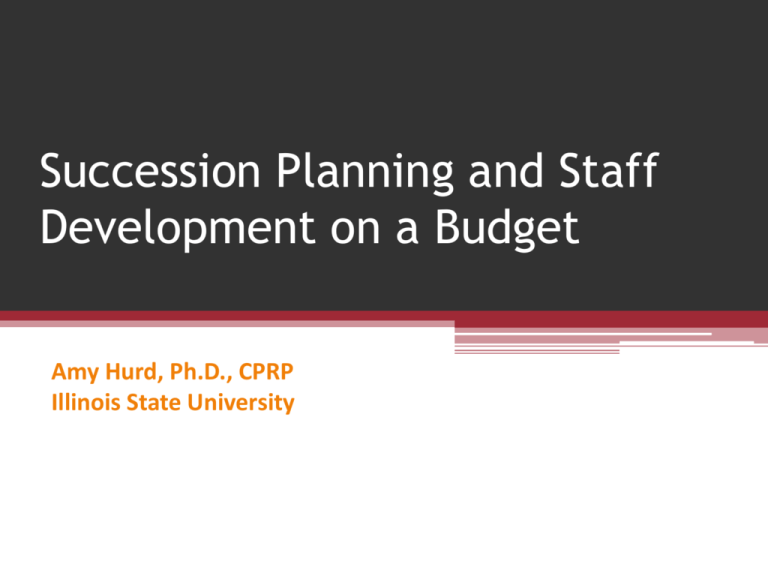
Succession Planning and Staff Development on a Budget Amy Hurd, Ph.D., CPRP Illinois State University Session Objectives • Identify succession planning needs and processes to implement succession plans into an agency • Understand and discuss competency progression from entry level practitioners to CEOs • Examine your own agency to determine the viability of successful staff development programs • Or….Walk away with 3-5 good ideas you can put to work Before we start…. • Any CEO’s • Upper Middle managers? • Good people to fill CEO position? • Upper Middle manager positions?... Before we start…. • Do you have a plan? • What does/doesn’t your plan address? • Is your department implementing its plan? • What are some weaknesses/strengths of the plan? Succession Planning • Right people in the right place at the right time to do the right things • Identifying and preparing suitable employees through training and mentoring to assume key positions within the organization. • Systematically designed to ensure continued effective performance in the future…not conferences & cross training • Match current talent to future needed talent Succession Planning Replacement Plans Succession Plans • Short term: 0-12 months • Focus on immediate needs • Develops back-up staff for key positions • Long-term: 12-36 months • Focus on future leadership • Develops leaders capable of filling multiple assignments • Very reactionary! What about progression plans?? The Situation… • The Boomer Effect ▫ 82.8 million boomers ▫ 1946-1964 ▫ 2010, 76 million ready for retirement ▫ Doesn’t account for death, illness, major life changes The Situation… • The Gen X & Y Effect (1965-1997) ▫ 53% seek better compensation and benefits. ▫ 35% cited dissatisfaction with potential career development. ▫ 32% said they were ready for a new experience. The Situation… • The Skilled Workforce Effect ▫ More jobs require skilled workforce ▫ Increased difficulty in filling these jobs M-NCPPC ▫ The economy! Why aren’t you doing this?? Why Isn’t Succession Planning More Common? ▫ ▫ ▫ ▫ Time consuming Important, but not urgent No immediate results Resistance from managers and directors (threatened) ▫ Mentality that employees are short-term Why SP Should be Common ▫ Leaders/potential leaders want to work for quality organizations…basic systems theory ▫ Provides an opportunity to identify potential leaders and groom them for advancement ▫ Helps the organization prepare for the future ▫ Encourages employee satisfaction and retention ▫ Organization can effectively function during a search ▫ Assures continuity and a strong organization Builds a strong core Are you sold on succession planning yet?? Succession Planning Steps Step 1- Understand Agency Development Needs Step 2- Assess Job Demands & Bench Strength Step 3- Build the Talent Pool Step 4- Facilitate Development Opportunities Step 1- Understand Agency Dev. Needs • Purposes ▫ Have high level replacement needs ▫ Need for structured ee development plans ▫ Desire a systematic process to review talent ▫ Desire a systematic process to forecast talent ▫ Establish a learning organization culture ▫ Increase agency quality, efficiency, effectiveness... Step 1- Understand Agency Development Needs Model for Effective Performance The individual’s competencies The job’s demands Effective specific actions or behaviors The organizational environment BALANCE Boyatzis (1982) Step 1- Understand Agency Dev. Needs • What will the program look like? ▫ How many participants ▫ Application process ▫ Tracks vs 1 program Step 1- Understand Agency Dev. Needs • How many participants ▫ Resources available ▫ Mentors available ▫ Sample size VBPRD 500+ ee’s, 64 applied, accepted 30 (6%) CPD 60 employees…10-20% Step 1- Understand Agency Dev. Needs • Application process…sample ▫ Application to the program… ▫ Resume ▫ Completed recommendation form from a full time employee higher in the organization than the applicant... ▫ Written approval of the applicant’s direct supervisor if they did not provide a letter of recommendation. Step 1- Understand Agency Dev. Needs Recreation & Admin. Track Operations (Maintenance) Track • Director Track ▫ CEO, rec & admin depart. Heads • Director Track ▫ Operations department heads and other director level employees (ie. Planners) • Coordinator/Manager Track ▫ Managers and coordinators within rec and admin • Supervisor/Specialist Track ▫ Supervisors, operations specialists, and foreman within operations. Succession Planning Steps Step 1- Understand Development Needs Step 2- Assess Job Demands & Bench Strength Step 3- Build the Talent Pool Step 4- Facilitate Development Opportunities Step 2- Assess Job Demands & Bench Strength • Know where you are before determining where you are going • Identify: ▫ Key positions Positions vs. levels ▫ Competencies needed for each position Competency progression ▫ Bench Strength Step 2- Assess Job Demands & Bench Strength • Key positions or levels…how to identify them ▫ Consequences of not filling a position Tasks or decisions put on hold Change in service levels Reduction in efficiency/effectiveness ▫ Look at organizational chart… What is the unique function of the job? Why is a position so important? Key skills? Can your organization operate without this position? Director Track – R & A Coordinator/Manager Track – R & A Director Track – Operations Supervisors/Specialists - Operations Step 2- Assess Job Demands & Bench Strength • Competencies ▫ Skills abilities required to perform the position ▫ Knowledge information required for the position ▫ Characteristics attitudes, personality factors or mental traits needed Step 2- Assess Job Demands & Bench Strength • Common Competencies ▫ ▫ ▫ ▫ ▫ ▫ ▫ ▫ ▫ Communication skills Customer service Leadership & management principles Creativity & innovation Multi-tasking & time management Flexible & adaptable Solve problems & make decisions Networking Comprehensive knowledge of the field Step 2- Assess Job Demands & Bench Strength • Understanding competencies will… ▫ Recognize the competency gap ▫ Align skills with strategic direction ▫ Help organization become “lean & mean” ▫ Guide hiring practices to hire right people Any bad hires? Why??? ▫ Predict success of employees Step 2- Assess Job Demands & Bench Strength Progression & types of competencies… Characteristics - soft skills › Be a self starter › Have patience › Ability to be creative & innovative Job skills - hard skills › Develop & stay within a budget › Establish priorities › Develop goals & objectives Step 2- Assess Job Demands & Bench Strength Characteristics CEO Job Skills Entry Level Step 2- Assess Job Demands & Bench Strength CEO Financial Management Understand personnel law Middle Mgr Manage multiple budgets Hire & supervise full time staff Entry level Develop program budget Supervise part time staff Step 2- Assess Job Demands & Bench Strength • Identify competencies for each job or level ▫ Job analysis Outlines roles, responsibilities, essential functions What people are expected to do What the person actually does & what others think they should do Results in a job description & task inventory Example…. Step 2- Assess Job Demands & Bench Strength Step 2- Assess Job Demands & Bench Strength • Identify competencies for each job or level ▫ Develop a competency based success profile each position Look beyond skills & knowledge Use research in the field Demonstrate understanding of ee development Step 2- Assess Job Demands & Bench Strength • Example of competency-based performance criteria ▫ Essential function Management ▫ Core Requirements = Communication Supervision Leadership Conflict Resolution ▫ Specific Responsibilities: CIP and Operating Budget Development Financial Analysis/Budget Monitoring Personnel Management Policy Development Virginia Beach Parks & Recreation Dept. Step 2- Assess Job Demands & Bench Strength • Example of competency-based performance criteria ▫ Essential function Landscape Management ▫ Core Requirements = Communication Supervision Leadership Coaching Conflict Resolution ▫ Specific Responsibilities: Irrigation system installation Plant identification, design, layout Soil analysis Storm water drainage system management Virginia Beach Parks & Recreation Dept. Step 2- Assess Job Demands & Bench Strength • Depth Chart to build bench strength CEO A.J. A. No internal candidate ready A. In emergency brd member X may step in B. Jack B. Ready in 2 years C. Mary C. Ready in 5 yrs, long shot, may not get there Step 2- Assess Job Demands & Bench Strength • Depth Chart to build bench strength Succession Candidates Position Incumbent(s) Ready Now Ready 1-2 Years Ready 2-5 years CEO Susan Smith Amanda Jones; Alex Green Greg Jarvis Eve Elwood Superintendent of Recreation Carlos Colon Judy Tang Steve Hem; Jordan Allen Anne Perez Director of Operations & Maintenance Tom Po Mitch White; Cassandra Jackson Felix Rodriguez Ali Ahmed Another eg… Step 2- Assess Job Demands & Bench Strength • Depth Chart to build bench strength Succession Candidates Position Incumbent(s) Ready Now CEO Susan Smith Amanda Jones; Alex Green Superintendent of Recreation Carlos Colon Director of Operations & Maintenance Tom Po Park Planner Kim Jones Your bench strength??? Ready 1-2 Years Ready 2-5 years Eve Elwood Steve Hem Ali Ahmed; Felix Rodriguez Succession Planning Steps Step 1- Understand Development Needs Step 2- Job Demands & Assess Bench Strength Step 3- Build the Talent Pool Step 4- Facilitate Development Opportunities Step 3- Build the Talent Pool • Focus on all levels within organizations ▫ Laborers through CEO ▫ FT and PT • Find your HiPos (High potentials) ▫ Capable of advancing 2-3 more levels ▫ Haven’t reached a career plateau ▫ Exceed minimum job expectations ▫ Self-actualizing ; committed to personal and professional improvement ▫ Who are the HiPos in your organization?? Performance/Potential Grid Future Potential High Low Stars Workhorses High low * Take steps to * Keep turnover low * Keep them motivated & accelerate their productive where development they are Questions Marks * Convert them to Low Present Performance * Keep turnover stars * Counsel them to Deadwood * Convert them to workhorses * Terminate them if accelerate their they can’t be development salvaged Odiome, G. S. (1984). Strategic management of human resources: A portfolio approach Step 3- Build the Talent Pool • Assess your HiPos ▫ Supervisor assessment based on competencies ▫ Self assessment ▫ Past performance appraisals ▫ 360 degree evaluation ▫ A few examples…. Conflict Management 5 4 Has high level of skill resolving differences & reaching agreement by maintaining a problem solving attitude 3 2 Has adequate skill resolving differences & reaching agreement by maintaining a problem solving attitude 1 Has little skill resolving differences & reaching agreement by maintaining a problem solving attitude Communication Skills 5 4 Always asks & answers questions clearly; displays good understanding of questions; demeanor is highly professional & friendly 3 Asks & answers most questions clearly; displays adequate understanding of questions; demeanor is generally professional 2 1 Questions & answers not clearly stated; often does not understand questions; demeanor is often unprofessional & unfriendly Champaign Park District Staff Development Program Recommendation Form – Director/Administrator Track Part 1: Competency Excellent Good Fair Poor Ability to manage projects 4 3 2 1 Ability to manage contracts 4 3 2 1 Ability to prepare specifications for 4 3 2 1 Develop and administer a budget 4 3 2 1 Financial management 4 3 2 1 bid documents Champaign Park District Staff Development Program Recommendation Form – Director/Administrator Track Part 2a: Performance Rating 1. Unsatisfactory results and performance 2. Marginal – does not meet requirements of position, remedial actions needed 3. Satisfactory – generally meets job requirements but room for improvement 4. Above average – surpass overall job requirements but lacks strength in some areas 5. Superior – some elements of performance may rate as exceptional, but overall performance falls below an exceptional rating 6. Exceptional – general all-around excellence in quality/quantity of work, initiative, self-development, new ideas, and attitude. Champaign Park District Staff Development Program Recommendation Form – Director/Administrator Track Part 2b: Potential to Advance 1. Outstanding – can advance two levels above present position 2. Considerable - can advance at least one level above present position and/or assume substantial added responsibility at present level 3. Some – can assume added responsibilities at present level 4. Limited – at or near capacity in present position 5. Key capacity in current position – vital technical knowledge precludes movement Champaign Park District Staff Development Program Recommendation Form – Director/Administrator Track Part 2c: Readiness to advance to next level 1. Qualified to move now 2. Within one to two years 3. Within two to four years 4. Current level appropriate Step 3- Build the Talent Pool • Assess your HiPos ▫ Self-assessment Complete recommendation form ▫ VBPRD Work portfolios Focus on outcomes of competencies ▫ VBPRD Assessment center Higher level scenarios to see how they perform Review solutions to scenarios Time consuming ▫ Others??? Step 3- Build the Talent Pool • The HiPo Profile ▫ ▫ ▫ ▫ ▫ ▫ Resume Competency Assessment Potential Assessment Strengths Development needs Individual development plan Step 3- Build the Talent Pool • Individual Development Plans ▫ Process of planning activities that will narrow the gap between what individuals can already do & what they should be able to do to meet future competency requirements in one or more key positions Step 3- Build the Talent Pool • Individual Development Plans ▫ Step 1: Identify potential job(s)/job level(s) ee wants ▫ Step 2: Discuss timeline ▫ Step 3: Discuss the competency gap ▫ Step 4: Set measurable learning objectives ▫ Step 5: Set strategies & ID resources to achieve objectives Resources: People, $, time, equipment ▫ Step 6: Est. how evidence of accomplishment is tracked Programs that Work E-Map = Employee Mobility Achievement Program Programs that Work Your logo here Concerns about “growing your own HiPos”??? Advantages? Disadvantages? Step 3- Build the Talent Pool • Advantages of growing your own ▫ Morale boosting ▫ Known quantity ▫ Retain institutional knowledge • Cautions on growing your own ▫ No heir apparent ▫ Talent pools are built to hire from with no guarantees for promotion ▫ Monitor internal competition among staff ▫ Heavy load on training & development Succession Planning Steps Step 1- Understand Development Needs Step 2- Assess Job Demands & Bench Strength Step 3- Build the Talent Pool Step 4- Facilitate Development Opportunities Step 4 - Facilitate Development Opportunities • Think about learning styles… Generation Ages Silent Attributes Learning Styles Training Style Management Style Born before 1946 Like hierarchy and order (64+) Comfortable with direct leadership Willing to climb the ladder patiently Difficult to adjust to change Auditory Data Monologue Classroom Formal Quite Control Authority Thinkers Baby Boomers 1946- 1964 (48-64) Believe in value of hard work Value democratic work environment View work groups as social groups Seek to change institutions Visual Metaphors Dialogue Roundtable Relaxed Planned Cooperation Competency Doers Generation X 1965-1977 (33-45) Want to be cutting edge Willing to break the rules Adaptive to change and new technology Kinesthetic Sensory Stories Unplanned Spontaneous Interactive Consensus Creativity Feelers Generation Y 1978-1990 (20-32) Instant Generation Tech Savvy Limited employee loyalty Upward mobility- no wait High performance & high maintenance Value input, feedback and mentoring Kinesthetic Sensory Stories Unplanned Interactive Fast Technology Question others Collaborators Change agents Virtual problem solvers Step 4 - Facilitate Development Opportunities • Lunch and Learn ▫ Able to build knowledge and common understanding within an organization ▫ Offered to all employees ▫ Leadership Topics Leadership, Communication, Decision Making ▫ Job Interview Skills Resume, Interview, Cover Letter • Book discussions ▫ Good to Great (Collins) ▫ Getting to Yes (Fischer & Ury) ▫ The Fifth Discipline: The Art and Practice of the Learning Organization (Senge) ▫ What Makes a Leader (Goleman) Step 4 - Facilitate Development Opportunities • Parks & Recreation Management University (M-NCPPC) ▫ Show them how to do it, do it with them, let them do it ▫ Immerse staff in operational issues Research & evaluation Registration & financial software packages Public affairs & marketing ▫ Found that staff did not have P & R backgrounds • Mentoring Programs Step 4 - Facilitate Development Opportunities Old Product Oriented Model • Transfer of knowledge from senior to junior staff member ▫ “I will teach what I know” • Setting up a mentoring program New Process Oriented Model • Knowledge acquisition, application & critical reflection ▫ “You will learn what you need to learn” • Supporting mentoring efforts Types of mentoring • One-on-One mentoring ▫ Traditional relationship • Reverse mentoring ▫ Jack Welch (GE) • Peer mentoring ▫ Often same level, experience & age IPRA Young Professionals • Supervisory mentoring ▫ Often informal relationship ▫ Problems??? Types of mentoring • Group mentoring ▫ ▫ ▫ ▫ Group of employees learn from 1 mentor Learning groups Mentor is the facilitator Group drives the learning agenda • Distance mentoring ▫ Utilize technology to communicate E-mail, chat room, IM PC/Web camera, Skype Discussion boards Step 4 - Facilitate Development Opportunities • Overview ▫ Understand learning styles ▫ Match learning style to training opportunities ▫ Support mentoring programs A sample program Transitional Leadership – Igniting the Fire Within P&R Mgmt University (M-NCPPC) • Rigorous application process ▫ Exceptional current job performance ▫ Completion of a basic leadership concepts course ▫ 3 references • Memorandum of Understanding ▫ Purpose, commitment, intent to stay 12 months • Classes ▫ 10 days intensive instruction ▫ 4 month experiential job assignment • Stipend for completing the training VBPRD – Leadership Development Program • Designed to prepare for promotional opportunities • Enrollment every other year • 5 Tracks ▫ Landscape Management ▫ Management ▫ Administrative support ▫ Programming ▫ Operations • Assigned a mentor • Sign a contract • Review progress on the development plan quarterly • Qualifications:…. VBPRD – Leadership Development Program • Qualifications: ▫ FT staff who has completed their 1 yr probation ▫ FT complete 1 yr after transferring from another dept. ▫ PT who has worked 1040 hours & has started accruing leave ▫ Plus: No disciplinary action for the past 18 months Supervisor approval VBPRD – Leadership Development Program • Stumbling Blocks ▫ Time commitment ▫ It took time to understand each others job responsibilities ▫ Seasonality – busy/slow times ▫ Some goals lead to certification – budget issue ▫ Existing workload problems ▫ Distance between mentor and mentee CPD – Staff Development Plan • Criteria ▫ Full time employee at the Champaign Park District. ▫ Three years of full or part time experience in the field. This experience can be with multiple agencies. ▫ Capable of advancing 2-3 more levels within a parks and recreation agency. A department head may participate if they have the ability to advance one additional level. ▫ Committed to professional advancement and improvement. Activity 1. Program requirements/qualifications 2. Application process, appointment, supervisor nomination 3. Number in the first class 4. How often is a new class started? 5. Plan to assess HiPos 6. Means of accountability to HiPos Thank you!!!! Amy R. Hurd, Ph.D., CPRP Associate Professor Illinois State University McCormick Hall 212 Normal, IL 61761 309-438-5557 arhurd@ilstu.edu http://www.castonline.ilstu.edu/hurd/nrpa.htm
